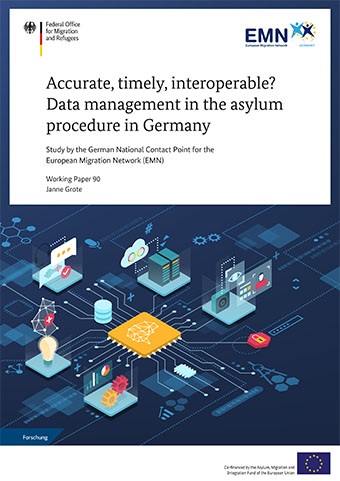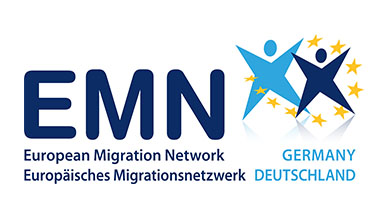Data management in the asylum procedure in Germany , , Study by EMN Germany for the European Migration Network
 Source: BAMF
Source: BAMF
Data of asylum seekers and asylum applicants are collected for the purpose of establishing and documenting identity, verifying the need for protection, as well as for administrative, integration and security-related purposes.
Data collection and data matching
The goal of today's data management in the asylum process is to achieve uniform data collection and storage at the earliest possible stage and a central storage system with specific access rights for all authorities involved. To this end, the authorities involved in the asylum procedure have been equipped with the appropriate technology to allow uniform data collection, security-relevant register cross-checks and automatic data storage in relevant databases from the earliest possible point in time.
Data protection and information provision to asylum seekers
In Germany and the EU, the right to informational self-determination applies to German and European citizens as well as to third-country nationals. At the same time, asylum seekers and asylum applicants have the right to be informed about the collection, storage and processing of data as well as their rights to information, modification, deletion and objection.
Data quality and data cleansing
Early uniform recording and storage of data avoids multiple registrations by different authorities. In addition, possible incorrect data entries and multiple registrations can be corrected by storing them in the Central Register of Foreigners, the core data system in the area of asylum and foreigners law, and previous stays and possible security-relevant knowledge can be identified at an early stage. Important further tools and methods of quality assurance in data management are data cleansing measures as well as the IDM-S tools of name transliteration and analysis, the web-based transcription service, speech and image biometrics and evaluation of mobile devices.
Challenges and best practices
The starting point and impetus for the numerous reforms regarding data management in the asylum procedure were various challenges that arose in the course of the high influx of asylum seekers in 2015 and 2016, which temporarily led to administrative overload in Germany. Among other things, lengthy and at times confusing (data processing) procedures at the individual authorities involved in the asylum procedure were identified as neuralgic points, which led, among other things, to multiple registrations as well as status, responsibility and benefit uncertainties for the asylum seekers and authorities involved. With regard to data management, two legal changes in particular were instrumental in addressing these challenges: the First and Second Data Sharing Improvement Acts. They formed the legal basis for the expansion of the Central Register of Foreigners into a core data system and the associated simplified conditions for storing additional information and for transmitting data to other public agencies.
Outlook
Parallel to the reforms carried out in Germany, processes of increased interoperability of national databases have been initiated at the European level, in which Germany has actively participated. The reform processes at the European level relate in particular to the creation of a "European Criminal Register Information System" (ECRIS), the addition of a "European Criminal Records Information System for Third Country Nationals" (ECRIS TCN), the creation of an "Entry/Exit System" (EES) and a "European Travel Information and Authorization System" (ETIAS). In addition, plans have been made to link the various EU databases.
Parallel to the national study, the comparative publications of the EMN provide an EU-wide perspective on data management in the asylum procedure in the EU Member States and Norway: the detailed EMN Synthesis Report, the concise EMN Inform and the one-page EMN Flash (see "Downloads" under "Further information").
The Study was authored by Janne Grote.

